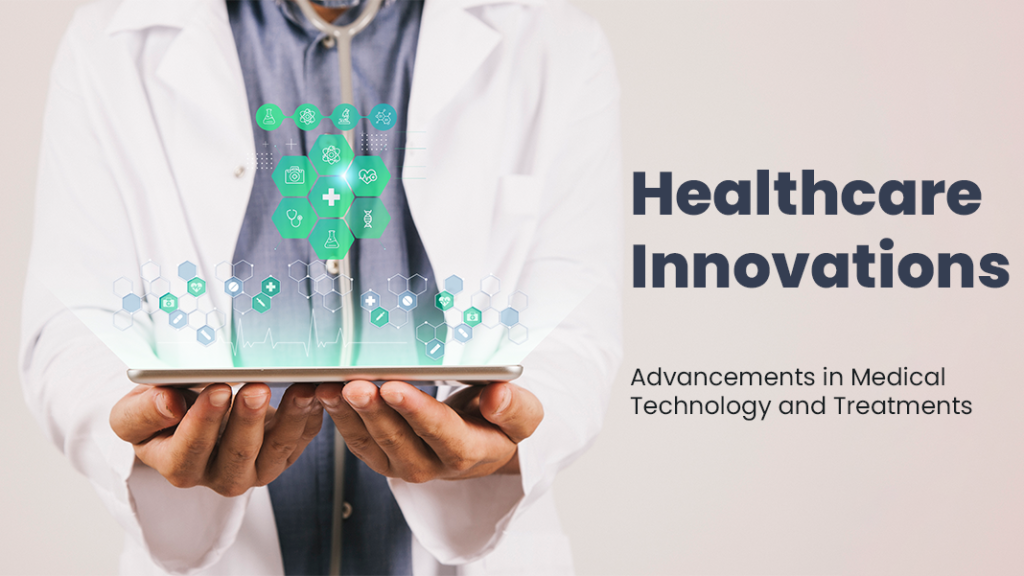Healthcare Innovations: Advancements in Medical Technology and Treatments
7 min read
Medical technology and therapies have undergone ground-breaking advancements that have fueled the industry’s ongoing evolution. These developments have the potential to completely change patient treatment, increase results, and improve the patient experience. In this blog, we’ll examine some of the most exciting medical advancements and highlight how they might affect healthcare in the future.
Precision Medicine: Pioneering Personalized Treatments:
Modern medicine uses precision medicine to personalize Medical technology care for each patient based on their genetic makeup, lifestyle choices, and environmental variables. Delivering targeted medicines thanks to this developing sector enables medical practitioners to treat patients more successfully and with fewer adverse effects. The WEF recognizes precision medicine as a ground-breaking innovation with the potential to improve patient outcomes and save a lot of money.
Telemedicine and Remote Patient Monitoring: Enhancing Accessibility and Convenience:
Particularly during the COVID-19 epidemic, telemedicine and remote patient monitoring systems have seen tremendous growth. Through these developments, patients can get remote access to medical consultations and monitoring, removing geographic restrictions and enhancing healthcare access in underserved areas. According to the AHA, telemedicine is a game-changer. In terms of providing quick and convenient care, cutting down on readmissions to hospitals, and giving patients more control over their own health.
Robotics and Minimally Invasive Surgery: Advancing Surgical Techniques:
Robotics innovations have completely changed how surgeries are performed. Making them less invasive, more precise, and requiring less time for patient recovery. With the aid of surgical robots, surgeons may carry out intricate surgeries with greater delicacy and accuracy. Robotic surgery is ranked as one of the top medical innovations. By the Cleveland Clinic due to its potential to enhance surgical results, lessen complications, and cut down on hospital stays.
Blockchain Technology: Securing Health Records and Enhancing Interoperability:
Medical records may now be shared and stored securely and openly thanks to blockchain technology. Which also improves data privacy and interoperability. Healthcare providers may guarantee the accuracy of patient data, simplify administrative procedures, and enable information sharing between various healthcare systems by utilizing blockchain. The AHA acknowledges that blockchain technology has the potential to enhance patient engagement, interoperability, and data management.
Genomic Medicine: Unlocking the Power of Genetic Information:
A deeper understanding of genetic differences and their consequences for illness prevention, diagnosis. And therapy has been made possible by developments in genomic medicine. Healthcare practitioners can detect genetic markers linked to certain disorders thanks to genomic sequencing and analysis, enabling early interventions and individualized treatment strategies. The WEF highlights how genomic medicine has the power to revolutionize healthcare by delivering personalized treatments and halting diseases in their tracks.
3D Printing in Healthcare: Customized Medical Solutions:
The development of individualized medical solutions is now possible because to the useful applications of 3D printing technology in the healthcare industry. Intricate and patient-specific designs can be produced using 3D printing for everything from prosthesis. To implants and even organ replicas for surgery planning. By offering individualized solutions that meet specific needs, enhancing treatment outcomes, and lowering costs, this invention has the potential to improve patient care. Additionally, 3D printing makes it possible to produce medical supplies quickly in times of need or in places with a shortage of resources, resolving a vital need and saving lives.
Virtual Reality (VR) and Augmented Reality (AR): Enhancing Training and Patient Engagement:
Experiences for patient engagement and medical teaching are changing thanks to virtual reality and augmented reality. In-depth virtual environments now allow medical practitioners to model difficult surgical operations, anatomy classes, and medical scenarios, offering opportunity for genuine hands-on training. Additionally, VR and AR have the potential to enhance patient involvement and education by better enabling people. To visualize their medical issues and available treatments. VR and AR technologies have the potential to improve healthcare outcomes and lower medical errors through improving training and patient comprehension.
Nanomedicine: Targeted Drug Delivery and Disease Monitoring:
Nanotechnology and nanoparticles are used in nanomedicine to deliver medications. Identify disorders, and keep tabs on people’s health at the molecular level. These tiny particles can be made to target particular cells or tissues. Making medicine administration more accurate and minimising unwanted effects. Nano sensors can also be used to track. Vital signs and find disease-related biomarkers. Enabling early intervention and individualized treatment plans. Drug delivery methods, disease detection. And monitoring could all be revolutionized by nanomedicine. Creating more efficient and individualized healthcare.
Internet of Medical Things (IoMT): Connected Healthcare Ecosystems:
The interconnected network of medical equipment, wearables, sensors, and healthcare systems is known as the Internet of Medical Things (IoMT). Real-time patient monitoring, remote diagnostics, and individual health management are all made possible by this technology. IoMT devices can gather and communicate crucial health data, enabling healthcare professionals to more effectively monitor patients’ states and make decisions. The IoMT also encourages the seamless integration of various healthcare systems, promoting patient outcomes and care coordination.
Bioprinting: Creating Functional Tissues and Organs:
To manufacture functional tissues and organs, the growing science of “bioprinting” blends 3D printing technology with bioengineering concepts. Researchers are able to print three-dimensional structures that resemble the intricacy of human tissues. Using specialized bionics that include living cells. By addressing the organ scarcity situation, bioprinting has the potential. To transform organ transplantation and create individualized tissue models for drug testing and disease research. Despite being in its infancy, bioprinting has enormous promise for regenerative medicine and has the power to revolutionize the transplantation industry.
Big Data Analytics: Harnessing the Power of Data for Healthcare Insights:
The use of big data analytics in healthcare has been made possible. By the exponential rise of healthcare data. Healthcare professionals can find patterns, trends, and correlations in massive datasets that can help with clinical decision-making, population health management, and disease surveillance. The creation of predictive. Models for early illness identification and epidemic prediction can also benefit from the use of big data analytics. This technology has the ability to enhance patient outcomes, streamline healthcare delivery, and sculpt evidence-based regulations.
The global COVID-19 pandemic role’s in healthcare innovations:
The worldwide COVID-19 epidemic has highlighted the crucial role that medical advancements play in managing and battling infectious diseases. The enormous demand on healthcare systems and the rapid spread of the virus have brought to light the critical need for cutting-edge medical technologies and therapies. Healthcare advances have been crucial in tackling the problems caused by COVID-19 and pointing us. In the direction of a more robust and ready future in the face of this unprecedented calamity.
Telemedicine is one area where advancements in healthcare have had a big impact throughout the pandemic. This has become a lifeline for both patients and medical professionals because to the requirement for physical separation and a decrease in in-person visits to healthcare facilities. Telemedicine allowed medical personnel to continue providing essential care. While lowering the danger of viral transmission through video consultations, remote patient monitoring, and virtual follow-ups. This technique not only made sure that people with problems unrelated to COVID could continue to get healthcare. But it also helped to lighten the load on healthcare systems. That were already overloaded with COVID-19 patients. Telemedicine has shown its promise as a crucial tool for enhancing healthcare. Accessibility and delivery, both during and after the epidemic, because to its scalability and adaptability.
COVID-19 Vaccinations Demonstrated
Additionally, the creation of COVID-19 vaccinations demonstrated the value of cooperation and hastened medical research. Advances in genetic medicine, AI-driven vaccine design, and unprecedented worldwide collaboration. Among researchers, pharmaceutical companies, and regulatory agencies allowed for the rapid development, testing, and approval of many vaccines. These developments not only revolutionized vaccine development but also made it possible to quickly identify and characterize novel viral types. The globe has been able to mount a successful response to the COVID-19 epidemic by utilizing cutting-edge Medical technology. And teamwork, saving countless lives and offering hope for a return to normalcy.
The significance of data management and analytics in healthcare. Has also been highlighted by the pandemic. Big data analytics has been important in tracking the virus’s progress, identifying hotspots, and guiding public health initiatives. Healthcare professionals have been able to make wise decisions, carry out focused therapies. And efficiently manage resources thanks to real-time analysis of enormous amounts of data. Additionally, research on COVID-19 therapies and outcomes. Has been helped by the integration of data from diverse sources, opening the door. To the development of novel therapy strategies. And a greater comprehension of the illness. The COVID-19 pandemic has presented. A number of obstacles. Which have been greatly helped by advancements in healthcare.
These developments have moulded the pandemic response and will continue to influence. How healthcare is provided in the future, from telemedicine enabling remote care delivery. To expedited vaccine research and data analytics guiding public health policies. Recognizing the revolutionary potential of medical technology. And treatments and promoting their integration into healthcare. Systems is essential as we work to navigate the current crisis and get ready for upcoming difficulties. Doing so will ensure preparation, resilience, and better patient outcomes.
Conclusion:
These developments promise more individualized care, improved accessibility, better surgical methods, secure data management, and more sophisticated illness prevention and diagnostics. To ensure the safe and efficient integration. Of these disruptive technologies into healthcare systems around the world. It is essential to develop collaboration, ethical concerns, and regulatory frameworks.







